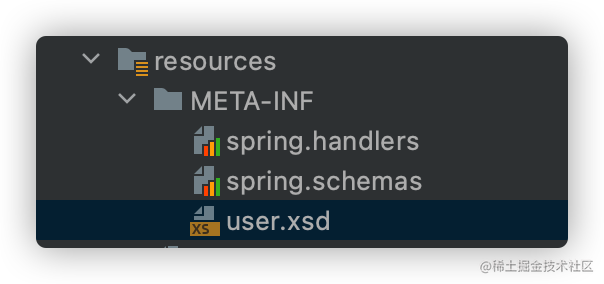我们平时使用spring的时候,基本都是直接使用spring内置的标签,比如常用的<bean>,<aop:>,<tx:>标签,如果要自定义一个spring标签如何处理?
- 创建一个自定义解析处理类(在init方法中添加parser类)
- 创建一个普通的spring.handlers配置文件,让应用程序能够完成加载工作
- 创建对应标签的parser类
- 创建自定义解析处理类
public class UserNamespaceHandler extends NamespaceHandlerSupport {
@Override
public void init() {
registerBeanDefinitionParser("user",new UserBeanDefinitionParser());
}
}
- 创建 spring.handlers 配置文件,文件内容如下:
http://www.spring.com/schema/user=com.dabao.selftag.UserNamespaceHandler
- 创建对应标签的parser类
public class UserBeanDefinitionParser extends AbstractSingleBeanDefinitionParser {
// 返回属性值所对应的对象
@Override
protected Class<?> getBeanClass(Element element) {
return User.class;
}
@Override
protected void doParse(Element element, BeanDefinitionBuilder builder) {
// 获取标签具体的属性值
String userName = element.getAttribute("userName");
String email = element.getAttribute("email");
String password = element.getAttribute("password");
if(StringUtils.hasText(userName)){
builder.addPropertyValue("username",userName);
}
if (StringUtils.hasText(email)){
builder.addPropertyValue("email",email);
}
if (StringUtils.hasText(password)){
builder.addPropertyValue("password",password);
}
}
}
- 定义标签对应的实体类
public class User {
private String username;
private String email;
private String password;
public String getUsername() {
return username;
}
public void setUsername(String username) {
this.username = username;
}
public String getEmail() {
return email;
}
public void setEmail(String email) {
this.email = email;
}
public String getPassword() {
return password;
}
public void setPassword(String password) {
this.password = password;
}
}
- 同时需要定义好对应的schema和xsd文件 spring.schemas文件内容
http://www.spring.com/schema/user.xsd=META-INF/user.xsd
user.xsd文件内容:
<?xml version="1.0" encoding="UTF-8"?>
<schema xmlns="http://www.w3.org/2001/XMLSchema"
targetNamespace="http://www.spring.com/schema/user"
elementFormDefault="qualified">
<element name="user">
<complexType>
<attribute name ="id" type = "string"/>
<attribute name ="userName" type = "string"/>
<attribute name ="email" type = "string"/>
<attribute name ="password" type="string"/>
</complexType>
</element>
</schema>

在xml中:
<?xml version="1.0" encoding="UTF-8"?>
<beans xmlns="http://www.springframework.org/schema/beans"
xmlns:xsi="http://www.w3.org/2001/XMLSchema-instance"
xmlns:aaa="http://www.spring.com/schema/user"
xsi:schemaLocation="http://www.springframework.org/schema/beans http://www.springframework.org/schema/beans/spring-beans.xsd
http://www.spring.com/schema/user http://www.spring.com/schema/user.xsd">
<aaa:user id = "testbean" userName = "lee" email = "bbb"/>
</beans>
跑一下:
public class TestSelfTag {
public static void main(String[] args) {
ApplicationContext context = new MyClassPathXmlApplicationContext("selftag.xml");
User user=(User)context.getBean("testbean");
System.out.println("username:"+user.getUsername()+" "+"email:"+user.getEmail());
}
}
结果: username:lee email:bbb
